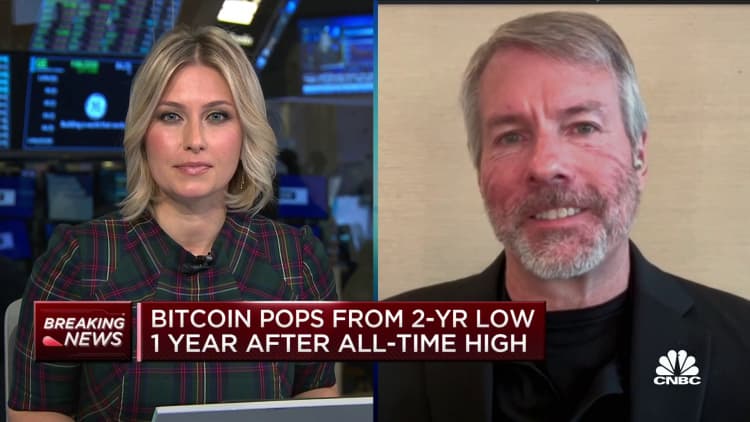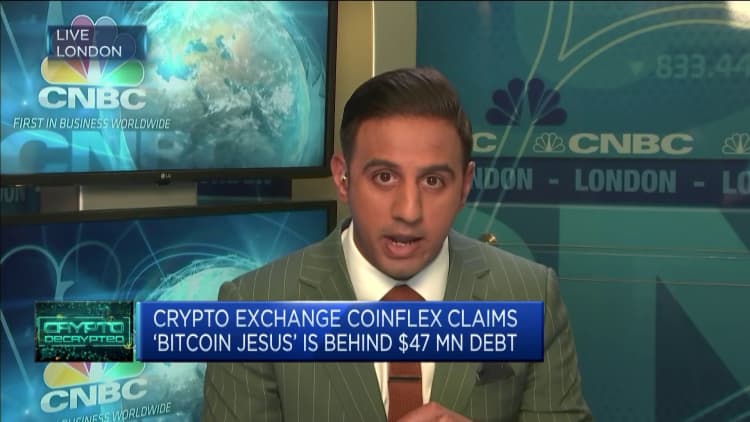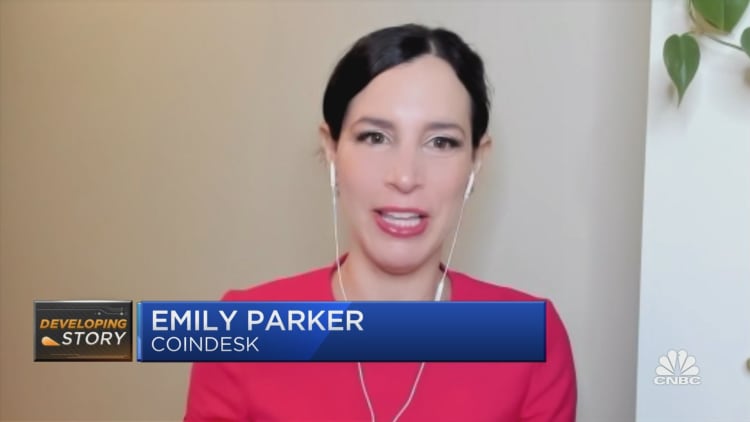Investors have lost more than $2 trillion since
An attendee wears a “Will Work for NFTs” shirt during the CoinDesk 2022 Consensus Festival in Austin, Texas, USA, Thursday, June 9, 2022. The festival showcases all sides of the blockchain, crypto, NFT and Web 3 ecosystems, and their far-reaching effect on trade, culture and local communities.
Jordan Vonderhaar | Bloomberg | Getty Images
A year ago this week, investors described bitcoin as the future of money and ethereum as the world’s most important developer tool. Non-fungible tokens exploded, Coin base traded at record highs and the NBA’s Miami Heat were just entering their first full season at the newly renamed FTX Arena.
As it turns out, it was top crypto.
During the past 12 months bitcoin peaking at over $68,000, the two biggest digital currencies have lost three-quarters of their value, collapsing alongside the riskiest tech stocks. The industry, once valued at around $3 trillion, is now around $900 billion.
Instead of acting as a hedge against inflation, which is near 40-year highs, bitcoin has turned out to be another speculative asset that bubbles up when evangelists get behind it and plummets when enthusiasm melts and investors get scared.
And the $135 million that FTX spent last year on a 19-year deal with the Heat? The crypto exchange with the naming rights is poised to land in the history books along with another brand that once had its logo on a sports facility: Enron.
In the blink of an eye this week, FTX plummeted from a $32 billion valuation to the brink of bankruptcy as liquidity dried up, customers demanded withdrawals and rival exchange Binance tore up its non-binding agreement to buy the company. FTX founder Sam Bankman-Fried admitted on Thursday that he “f—ed up”.
“Looking back now, the excitement and asset prices were clearly getting ahead of themselves and trading way above any fundamental value,” said Katie Talati, director of research at Arca, an investment firm focused on digital assets. “Because the downturn was so swift and violent, many have proclaimed that digital assets are dead.”
Whether crypto is forever doomed or will bounce back, as Talati expects, the 2022 carnage exposed the industry’s many flaws and served as a reminder to investors and the public why financial regulation exists. Bankruptcies have been coming fast and furious since the middle of the year, leaving clients with crypto accounts unable to access their funds and in some cases scrapping for pennies on the dollar.
If this is indeed the future of finance, it looks pretty bleak.
Crypto was supposed to provide transparency. Transactions on the blockchain are all traceable. We didn’t need centralized institutions – banks – because we had digital ledgers as the only source of truth.
That narrative is gone.
“Speaking for the bitcoiners, we feel we are trapped in a dysfunctional relationship with crypto and we want out,” said Michael Saylor, executive chairman of Micro strategy, a technology company that owns 130,000 bitcoins. “The industry needs to grow up and the regulators get into this space. The future of the industry is registered digital assets traded on regulated exchanges, where everyone has the investor protection they need.”

Saylor was speaking on CNBC’s “Squawk on the Street” as FTX’s demise rattled the crypto market. Bitcoin sank to a two-year low this week, before retreating on Thursday. Ethereum also the tank, and solana, another popular coin used by developers and the spying of Bankman-Fried, fell by more than half.
Stocks linked to crypto also suffered. Crypto exchange Coinbase fell 20% over two days, while Robin Hoodthe trading app, which counts Bankman-Fried as one of its biggest investors, fell 30% in the same period.
It was already a lot of pain to walk around. Last week, Coinbase reported a revenue drop of more than 50% in the third quarter from a year earlier, and a loss of $545 million. In June, the crypto exchange cut 18% of its workforce.
“We are actively updating and evaluating our scenario plans and are prepared to further reduce operating expenses if market conditions worsen,” said Alesia Haas, Coinbase’s chief financial officer, on the Nov. 3 earnings call.
How it started
The drawdown started at the end of 2021. That’s when inflation rates started to rise and sparked concerns that the Federal Reserve would start raising borrowing costs when the calendar turned. Bitcoin fell 19% in December, as investors rotated into assets considered safer in a turbulent economy.
The selloff continued in January, with bitcoin down 17% and ethereum down 26%. David Marcus, former head of crypto at Facebook parent Metaused a phrase that would soon enter the lexicon.
“It’s during crypto winters that the best entrepreneurs build the best companies,” Marcus wrote in a tweet on January 24. “This is the time again to focus on solving real problems versus pumping tokens.”
The crypto winter didn’t actually hit for a few months. The markets even stabilized for a short while. Then, in May, stablecoins officially became unstable.
A stablecoin is a type of digital currency designed to maintain a 1-to-1 peg to the US dollar, acting as a sort of bank account for the crypto-economy and offering a solid store of value, unlike the volatility experienced in bitcoin and other digital currencies .
When TerraUSD, or UST, and its sister token called luna dove below the $1 mark, a different kind of panic set in. The stick had been broken. Confidence disappeared. More than $40 billion in assets were wiped out in Luna’s collapse. Suddenly, it was as if nothing in crypto was safe.
The leading cryptocurrencies cratered, with bitcoin plunging 16% in a single week, bringing it down by more than half from its peak six months earlier. On the macro front, inflation had shown no sign of abating, and the central bank remained committed to raising interest rates as much as would be necessary to slow the rise in consumer prices.
In June, the bottom fell out.
Lending platform Celsius paused withdrawals due to “extreme market conditions.” Binance also halted withdrawals, while crypto lender BlockFi cut 20% of its workforce after more than quintupling since late 2020.

Prominent crypto hedge fund Three Arrows Capital (3AC) defaulted on a loan worth more than $670 million, and FTX signed a deal that gave it the option to buy BlockFi at a fraction of the company’s last private valuation.
Bitcoin had its worst month ever in June, losing roughly 38% of its value. Ether fell by more than 40%.
Then came the bankruptcies.
Singapore-based 3AC filed for bankruptcy protection in July, just months after disclosing it had $10 billion in assets. The firm’s risky strategy involved borrowing money from the entire industry and then turning around and investing the capital in other, often nascent, crypto projects.
After 3AC fell, crypto brokerage Voyager Digital wasn’t far behind. That’s because 3AC’s massive default was on a Voyager loan.
“We strongly believe in the future of the industry, but the prolonged volatility of the crypto markets, and the default of Three Arrows Capital, require us to take this decisive action,” Voyager CEO Stephen Ehrlich said at the time.
Next was Celsius, which filed for Chapter 11 protection in mid-July. The company had been paying customers interest rates of up to 17% to store crypto on the platform. It would lend these assets to counterparties willing to pay sky-high rates. The structure collapsed as liquidity dried up.
Meanwhile, Bankman-Fried set out to be an industry savior. The 30-year-old, who lived in the Bahamas, was ready to address the carnage and consolidate the industry, arguing that FTX was in a better position than its peers because it stashed away cash, kept costs low and avoided borrowing. With a net worth that on paper had risen to $17 billion, he personally bought a 7.6% stake in Robinhood.
SBF, as he is known, was called by some the “JPMorgan of crypto.” He told CNBC’s Kate Rooney in September that the company had close to $1 billion to spend on bailouts if the right opportunities arose to keep key players afloat.
“It’s not going to be good for anybody in the long term if we have real pain, if we have real blowouts, and it’s not fair to customers and it’s not going to be good for regulation. It’s not going to be good for something,” Bankman – said Fried. “From a long-term perspective, that’s what was important for the ecosystem, that’s what was important for the customers and that’s what was important for people to be able to operate in the ecosystem without being terrified of unknown unknowns blowing them up in one way or another .”

It’s almost as if Bankman-Fried was describing her own destiny.
FTX’s meteoric descent began last weekend after Binance CEO Changpeng Zhao tweeted that his company was selling the last of its FTT tokens, the native currency of FTX. It followed an article in CoinDesk, which pointed out that Alameda Research, Bankman-Fried’s hedge fund, had an outsized amount of FTT on its balance sheet.
Not only did Zhao’s public statement cause the price of FTT to drop, it caused FTX customers to hit the exits. Bankman-Fried said in a tweet Thursday that FTX clients on Sunday called for roughly $5 billion in withdrawals, which he called “the largest by a wide margin.” Lacking reserves to cover the virtual bank run, FTX turned to Zhao for help.
How are you
Binance announced a non-binding agreement to buy FTX on Tuesday, in a deal that would have been so disastrous for FTX that equity investors expected to be wiped out. But Binance reversed course a day later, saying FTX’s “problems are beyond our control or ability to help.”
Bankman-Fried has since wrangled billions of dollars in an effort to stay out of bankruptcy. He says he has also worked to maintain liquidity so customers can get their money out.
Venture firm Sequoia Capital, which first backed FTX in 2021 at a $18 billion valuation, said it marked its $213.5 million investment in FTX “down to 0.” Multicoin Capital, a crypto investment firm, told limited partners on Tuesday that while it was able to retrieve about a quarter of its assets from FTX, the funds still stranded there represented 15.6% of the fund’s assets, and there is no guarantee for everything will do. be brought in.
In addition, Multicoin said it is taking a hit because its largest position is in Solana, which fell in value because it was “generally considered to be within SBF’s sphere of influence.” The firm said it is sticking to its mission statement and looking for assets that can “outperform market beta across market cycles.”
“We are not short-term or momentum traders, and we do not operate on short time horizons,” Multicoin said. “While this situation is painful, we are going to continue to focus on our strategy.”
It won’t be easy.
Ryan Gilbert, founder of fintech venture firm Launchpad Capital, said the crypto world is facing a crisis of confidence following the FTX implosion. While it was already a tumultuous year for crypto, Gilbert said Bankman-Friedman was a trusted leader who was comfortable representing the industry on Capitol Hill.
In a market without a central bank, an insurance company or any institutional protection, trust is essential.
“It’s a question of, can trust even exist in this industry at this stage of the game?” Gilbert said in an interview Thursday. “To a large extent, the concept of trust is as bankrupt as any of these companies.”
SEE: Crypto exchanges are warping


